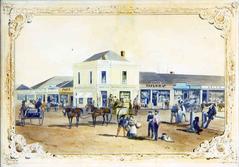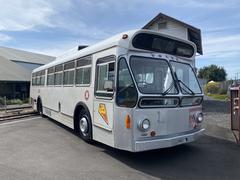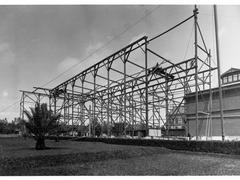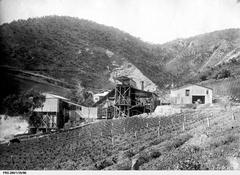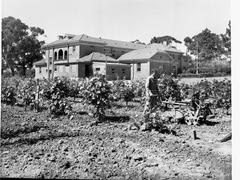Visiting Adelaide Dolphin Sanctuary: Hours, Tickets, and Tips
Date: 31/07/2024
Introduction
Nestled on the east coast of Gulf St Vincent, the Adelaide Dolphin Sanctuary (ADS) offers a unique urban wildlife experience that is unparalleled globally. Established in 2005, the sanctuary protects a resident population of Indo-Pacific bottlenose dolphins and provides visitors with an opportunity to engage with these magnificent creatures in their natural habitat. Covering an area of 118.75 square kilometers, the sanctuary is a mosaic of diverse habitats including mangrove forests, seagrass meadows, and tidal flats, making it a haven for various marine and bird species (Parks SA). The ADS is not just an ecological treasure but also holds significant cultural and historical value, with deep-rooted connections to the Kaurna people and a rich maritime history (Wikipedia). This comprehensive guide aims to provide all the essential information you need to plan your visit, from ticket prices and visiting hours to conservation efforts and community involvement.
Table of Contents
- [Introduction](#introductionintroduction)
- [History and Significance](#history-and-significancehistory-and-significance)
- [Establishment of the Adelaide Dolphin Sanctuary](#establishment-of-the-adelaide-dolphin-sanctuaryestablishment-of-the-adelaide-dolphin-sanctuary)
- [Geographic and Ecological Importance](#geographic-and-ecological-importancegeographic-and-ecological-importance)
- [Unique Urban Wildlife Experience](#unique-urban-wildlife-experienceunique-urban-wildlife-experience)
- [Cultural and Historical Significance](#cultural-and-historical-significancecultural-and-historical-significance)
- [Governance and Management](#governance-and-managementgovernance-and-management)
- [Conservation Efforts and Community Involvement](#conservation-efforts-and-community-involvementconservation-efforts-and-community-involvement)
- [Visitor Experience and Activities](#visitor-experience-and-activitiesvisitor-experience-and-activities)
- [Notable Wildlife Sightings](#notable-wildlife-sightingsnotable-wildlife-sightings)
- [Insider Tips for Visitors](#insider-tips-for-visitorsinsider-tips-for-visitors)
- [Visitor Information](#visitor-informationvisitor-information)
- [Ticket Prices and Opening Hours](#ticket-prices-and-opening-hoursticket-prices-and-opening-hours)
- [Travel Tips and Nearby Attractions](#travel-tips-and-nearby-attractionstravel-tips-and-nearby-attractions)
- [Special Events and Guided Tours](#special-events-and-guided-toursspecial-events-and-guided-tours)
- [Future Prospects and Challenges](#future-prospects-and-challengesfuture-prospects-and-challenges)
- [Conclusion](#conclusionconclusion)
- [FAQ](#faqfaq)
History and Significance
Establishment of the Adelaide Dolphin Sanctuary
The Adelaide Dolphin Sanctuary (ADS) was officially established in 2005, following years of advocacy and lobbying by dolphin expert Mike Bossley AM. Bossley became interested in the local dolphin population in the mid-1990s after reading about a dolphin that swam alongside racehorses being exercised in the waters off West Beach. His efforts culminated in the creation of the sanctuary, which aims to protect a resident population of Indo-Pacific bottlenose dolphins (Wikipedia).
Geographic and Ecological Importance
The ADS is located on the east coast of Gulf St Vincent, encompassing the estuary of the Port River around Port Adelaide and extending northwards past St Kilda. Covering an area of 118.75 square kilometers, the sanctuary includes diverse habitats such as mangrove forests, seagrass meadows, saltmarshes, tidal flats, and tidal creeks. These habitats provide essential food and shelter for the resident dolphin population and other marine life (Parks SA).
Unique Urban Wildlife Experience
Adelaide is touted as the only city in the world with wild dolphins living within its metropolitan area. This unique feature makes the ADS a significant tourist attraction, drawing dolphin enthusiasts and casual visitors alike. The sanctuary is home to around 30 resident bottlenose dolphins, with an additional 400 transient dolphins visiting at various times. These dolphins come to the sanctuary to feed, play, socialize, and nurse their calves (Environment SA).
Cultural and Historical Significance
The ADS is not only important for its ecological value but also for its cultural and historical significance. The area includes several Aboriginal and European cultural and historical sites. The Port Adelaide River estuary and Barker Inlet have long-standing relationships with the indigenous communities, and these connections are recognized and respected in the sanctuary’s management practices. Public awareness campaigns emphasize the importance of a healthy estuary for the economic, social, and cultural prosperity of local communities (Wikipedia).
Governance and Management
The ADS is managed by the National Parks and Wildlife Service South Australia, an agency within the Department of Environment and Water. The sanctuary is classified as an IUCN Category VI protected area, which means it is managed mainly for the sustainable use of natural ecosystems. The management practices include additional regulatory requirements regarding commercial activities, especially those involving interactions with marine mammals (Wikipedia).
Conservation Efforts and Community Involvement
Conservation efforts in the ADS are multifaceted, involving habitat protection, pollution control, and community engagement. The sanctuary’s management team works closely with local communities to promote ecological sustainable development. Public participation is encouraged in various processes associated with the management of the Port Adelaide River estuary and Barker Inlet. Educational programs and community outreach initiatives aim to raise awareness about the importance of preserving this unique marine environment (Parks SA).
Visitor Experience and Activities
Visitors to the ADS can engage in a variety of activities, including dolphin watching, kayaking, and coastal walks. The sanctuary offers several boat tours, such as the Dolphin Explorer, which provide excellent opportunities to observe the dolphins in their natural habitat. Kayaking through the mangrove-lined creeks and the Ship’s Graveyard offers a more adventurous way to explore the sanctuary. The best times for dolphin spotting are during the winter months, particularly around Garden Island and the inner Port River (Environment SA).
Notable Wildlife Sightings
In addition to dolphins, the ADS is home to other notable wildlife, including long-nosed fur seals. These seals, which were nearly hunted to extinction between 1800 and 1830, have made a remarkable recovery, with about 100,000 now living around South Australia. The sanctuary also occasionally receives visits from southern right whales and humpback whales, adding to the diversity of marine life that can be observed (Environment SA).
Insider Tips for Visitors
For the best experience, visitors are advised to explore the sanctuary on calm, sunny days when the waters are glassy and sightings are almost guaranteed. The Port River and its industrialized environment are just the tip of the iceberg; kayaking around Garden Island, Barker Inlet, Torrens Island, or Section Bank reveals the true beauty of this ‘port paradise.’ The Dolphin Display Room at the Port Adelaide Visitor Information Centre is a great starting point to learn about the sanctuary and pick up maps and information (Parks SA).
Visitor Information
Ticket Prices and Opening Hours
The Adelaide Dolphin Sanctuary is open year-round. While there is no entry fee to the sanctuary itself, certain activities such as boat tours may have associated costs. The Dolphin Explorer tours typically operate twice daily, with tickets priced around AUD 25 for adults and AUD 15 for children. Kayak rentals are also available at varying rates.
Travel Tips and Nearby Attractions
The sanctuary is easily accessible by car or public transport from Adelaide city center. Visitors should consider combining their trip with visits to nearby attractions such as the South Australian Maritime Museum, Port Adelaide Lighthouse, and the historic district of Port Adelaide. These sites offer additional insights into the region’s rich maritime history and cultural heritage.
Special Events and Guided Tours
Special events and guided tours are frequently organized within the ADS. These include educational programs, wildlife photography sessions, and guided nature walks. Check the official ADS website or contact the Port Adelaide Visitor Information Centre for updated schedules and booking information.
Future Prospects and Challenges
The ADS faces ongoing challenges, including habitat degradation, pollution, and the impacts of climate change. Continued efforts are needed to address these issues and ensure the long-term sustainability of the sanctuary. The involvement of local communities, government agencies, and conservation organizations will be crucial in overcoming these challenges and preserving the ADS for future generations (Wikipedia).
Conclusion
By understanding the history and significance of the Adelaide Dolphin Sanctuary, visitors can appreciate the efforts that have gone into creating and maintaining this unique marine environment. Whether through educational programs, conservation initiatives, or simply enjoying the natural beauty of the sanctuary, everyone can play a part in protecting this valuable ecological and cultural asset. Plan your visit today and immerse yourself in the natural wonders of the ADS.
FAQ
Q: What are the Adelaide Dolphin Sanctuary visiting hours?
A: The sanctuary is open year-round. Specific activity hours, such as boat tours, may vary.
Q: How much do tickets cost for the Adelaide Dolphin Sanctuary?
A: Entry to the sanctuary is free, but activities like boat tours may have associated costs. For instance, Dolphin Explorer tickets are around AUD 25 for adults and AUD 15 for children.
Q: Are there any guided tours available?
A: Yes, guided tours and special events are frequently organized. Check the official ADS website for the latest information.
Q: What other attractions are nearby?
A: Nearby attractions include the South Australian Maritime Museum, Port Adelaide Lighthouse, and the historic district of Port Adelaide.
References
- Parks SA. (n.d.). Adelaide Dolphin Sanctuary. https://www.parks.sa.gov.au/parks/adelaide-dolphin-sanctuary
- Wikipedia. (n.d.). Adelaide Dolphin Sanctuary. https://en.wikipedia.org/wiki/Adelaide_Dolphin_Sanctuary
- Environment SA. (2019, November). Bird & Dolphins Itinerary. https://www.environment.sa.gov.au/goodliving/posts/2019/11/bird-dolphins-itinerary


